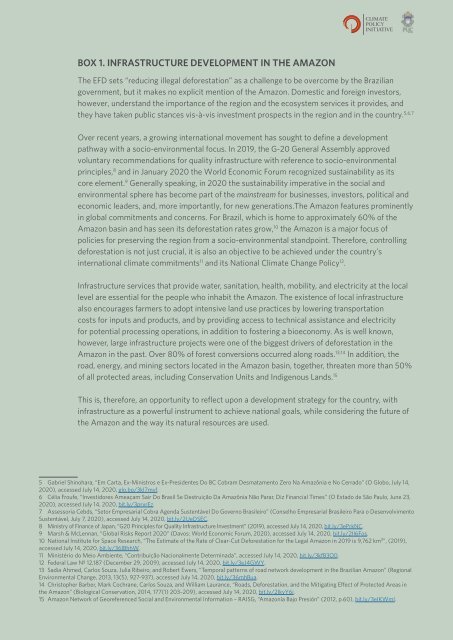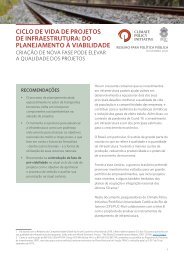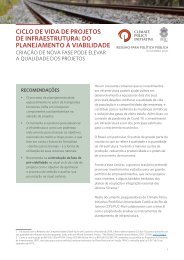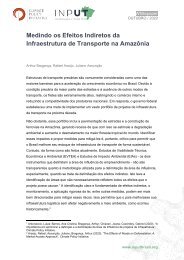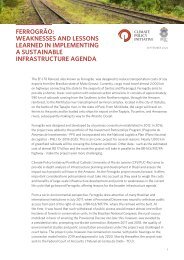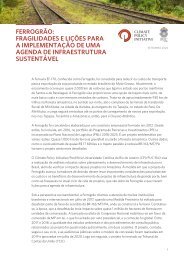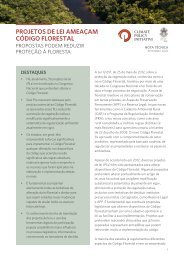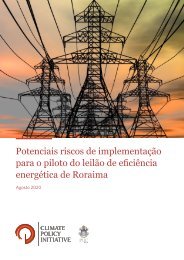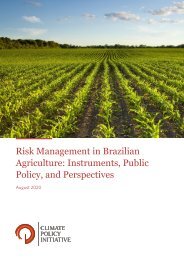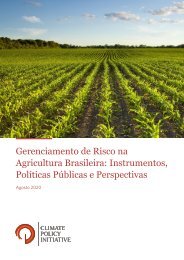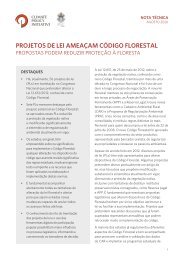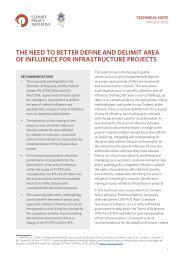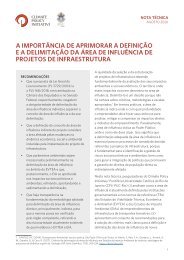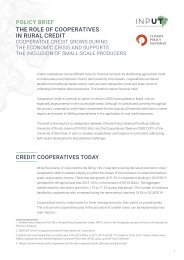Brazil’s Infrastructure Project Life Cycles: from Planning to Viability. Creation of a New Phase May Increase Project Quality
You also want an ePaper? Increase the reach of your titles
YUMPU automatically turns print PDFs into web optimized ePapers that Google loves.
BOX 1. INFRASTRUCTURE DEVELOPMENT IN THE AMAZON<br />
The EFD sets “reducing illegal deforestation” as a challenge <strong>to</strong> be overcome by the Brazilian<br />
government, but it makes no explicit mention <strong>of</strong> the Amazon. Domestic and foreign inves<strong>to</strong>rs,<br />
however, understand the importance <strong>of</strong> the region and the ecosystem services it provides, and<br />
they have taken public stances vis-à-vis investment prospects in the region and in the country. 5,6,7<br />
Over recent years, a growing international movement has sought <strong>to</strong> define a development<br />
pathway with a socio-environmental focus. In 2019, the G-20 General Assembly approved<br />
voluntary recommendations for quality infrastructure with reference <strong>to</strong> socio-environmental<br />
principles, 8 and in January 2020 the World Economic Forum recognized sustainability as its<br />
core element. 9 Generally speaking, in 2020 the sustainability imperative in the social and<br />
environmental sphere has become part <strong>of</strong> the mainstream for businesses, inves<strong>to</strong>rs, political and<br />
economic leaders, and, more importantly, for new generations.The Amazon features prominently<br />
in global commitments and concerns. For Brazil, which is home <strong>to</strong> approximately 60% <strong>of</strong> the<br />
Amazon basin and has seen its deforestation rates grow, 10 the Amazon is a major focus <strong>of</strong><br />
policies for preserving the region <strong>from</strong> a socio-environmental standpoint. Therefore, controlling<br />
deforestation is not just crucial, it is also an objective <strong>to</strong> be achieved under the country’s<br />
international climate commitments 11 and its National Climate Change Policy 12 .<br />
<strong>Infrastructure</strong> services that provide water, sanitation, health, mobility, and electricity at the local<br />
level are essential for the people who inhabit the Amazon. The existence <strong>of</strong> local infrastructure<br />
also encourages farmers <strong>to</strong> adopt intensive land use practices by lowering transportation<br />
costs for inputs and products, and by providing access <strong>to</strong> technical assistance and electricity<br />
for potential processing operations, in addition <strong>to</strong> fostering a bioeconomy. As is well known,<br />
however, large infrastructure projects were one <strong>of</strong> the biggest drivers <strong>of</strong> deforestation in the<br />
Amazon in the past. Over 80% <strong>of</strong> forest conversions occurred along roads. 13,14 In addition, the<br />
road, energy, and mining sec<strong>to</strong>rs located in the Amazon basin, <strong>to</strong>gether, threaten more than 50%<br />
<strong>of</strong> all protected areas, including Conservation Units and Indigenous Lands. 15<br />
This is, therefore, an opportunity <strong>to</strong> reflect upon a development strategy for the country, with<br />
infrastructure as a powerful instrument <strong>to</strong> achieve national goals, while considering the future <strong>of</strong><br />
the Amazon and the way its natural resources are used.<br />
5 Gabriel Shinohara, “Em Carta, Ex-Ministros e Ex-Presidentes Do BC Cobram Desmatamen<strong>to</strong> Zero Na Amazônia e No Cerrado” (O Globo, July 14,<br />
2020), accessed July 14, 2020, glo.bo/3kl7mvf.<br />
6 Célia Froufe, “Investidores Ameaçam Sair Do Brasil Se Destruição Da Amazônia Não Parar, Diz Financial Times” (O Estado de São Paulo, June 23,<br />
2020), accessed July 14, 2020, bit.ly/3prvrEz.<br />
7 Assessoria Cebds, “Se<strong>to</strong>r Empresarial Cobra Agenda Sustentável Do Governo Brasileiro” (Conselho Empresarial Brasileiro Para o Desenvolvimen<strong>to</strong><br />
Sustentável, July 7, 2020), accessed July 14, 2020, bit.ly/2UeDSEC.<br />
8 Ministry <strong>of</strong> Finance <strong>of</strong> Japan, “G20 Principles for <strong>Quality</strong> <strong>Infrastructure</strong> Investment” (2019), accessed July 14, 2020, bit.ly/3ePrkNC.<br />
9 Marsh & McLennan, “Global Risks Report 2020” (Davos: World Economic Forum, 2020), accessed July 14, 2020, bit.ly/2Il6Fos.<br />
10 National Institute for Space Research, “The Estimate <strong>of</strong> the Rate <strong>of</strong> Clear-Cut Deforestation for the Legal Amazon in 2019 is 9,762 km²”, (2019),<br />
accessed July 14, 2020, bit.ly/36lBhhW.<br />
11 Ministério do Meio Ambiente, “Contribuição Nacionalmente Determinada”, accessed July 14, 2020, bit.ly/3kfB3O0.<br />
12 Federal Law Nº 12,187 (December 29, 2009), accessed July 14, 2020, bit.ly/3eJ4GWY.<br />
13 Sadia Ahmed, Carlos Souza, Julia Ribeiro, and Robert Ewers, “Temporal patterns <strong>of</strong> road network development in the Brazilian Amazon” (Regional<br />
Environmental Change, 2013, 13(5), 927-937), accessed July 14, 2020, bit.ly/36mhBua.<br />
14 Chris<strong>to</strong>pher Barber, Mark Cochrane, Carlos Souza, and William Laurance, “Roads, Deforestation, and the Mitigating Effect <strong>of</strong> Protected Areas in<br />
the Amazon” (Biological Conservation, 2014, 177(1) 203–209), accessed July 14, 2020, bit.ly/2IkyY6i.<br />
15 Amazon Network <strong>of</strong> Georeferenced Social and Environmental Information – RAISG, “Amazonía Bajo Presión” (2012, p.60), bit.ly/3eIKWml.<br />
4


